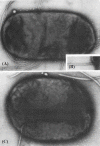The discovery of cholera - like enterotoxins produced by Escherichia coli causing secretory diarrhoea in humans
- PMID: 21415491
- PMCID: PMC3089048
The discovery of cholera - like enterotoxins produced by Escherichia coli causing secretory diarrhoea in humans
Abstract
Non-vibrio cholera has been recognized as a clinical entity for as long as cholera was known to be caused by Vibrio cholerae. Until 1968, the aetiologic agent of this syndrome was not known. Following a series of studies in patients with non-vibrio cholera it was found that these patients had large concentrations of Escherichia coli in the small bowel and stools which produced cholera toxin-like enterotoxins, and had fluid and electrolyte transport abnormalities in the small bowel similar to patients with documented cholera. Furthermore, these patients developed antibodies to the cholera-like enterotoxin. Later studies showed that these strains, when fed to volunteers produced a cholera-like disease and that two enterotoxins were found to be produced by these organisms: a heat-labile enterotoxin (LT) which is nearly identical to cholera toxin, and a heat-stable enterotoxin (ST), a small molecular weight polypeptide. E. coli that produced one or both of these enterotoxins were designated enterotoxigenic E. coli (ETEC). ETEC are now known not only to cause a severe cholera-like illness, but to be the most common bacterial cause of acute diarrhoea in children in the developing world, and to be the most common cause of travellers' diarrhoea in persons who visit the developing world.
Figures







References
-
- De SN, Chatterje DN. An experimental study of the mechanism of action of Vibrio cholerae on the intestinal mucous membrane. J Pathol Bacteriol. 1953;66:559–62. - PubMed
-
- De SN. Enterotoxicity of bacteria-free culture-filtrate of Vibrio cholerae. Nature. 1959;183:1533–4. - PubMed
-
- De SN, Bhattacharya K, Sarkar JK. A study of the pathogenicity of strains of Bacterium coli from acute and chronic enteritis. J Pathol Bacteriol. 1956;71:201–9. - PubMed
-
- De SN. Cholera: its pathology and pathogenesis. Edinburgh: Oliver and Boyd; 1961.
-
- Taylor J, Bettelheim KA. The action of chloroform-killed suspensions of enteropathogenic Escherichia coli on ligated rabbit-gut segments. J Gen Microbiol. 1966;42:309–13. - PubMed
Publication types
MeSH terms
Substances
LinkOut - more resources
Full Text Sources
Medical
